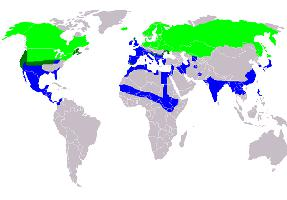
Popis zvířete
The Pintail, scientifically known as Anas acuta, is a graceful, medium-sized dabbling duck that is widely admired for its elegant appearance and distinctive features. Characterized by its long, slender neck and a tail that tapers to a sharp point—features that have earned it the name 'Pintail'—this species exhibits pronounced sexual dimorphism, meaning that males and females have markedly different plumages.Males, or drakes, are particularly striking during the breeding season. They boast a chocolate-brown head with a white stripe running from the back of the neck down to the side of the breast. Their upper bodies are cloaked in a subtle grey, adorned with fine, white lines that give the impression of meticulous grooming. The back is a darker shade, providing a beautiful contrast with the bird's white underparts. The most distinguishing feature, however, is the long, central tail feathers that extend well beyond the rest of the tail, tapering to a fine point. The bill is dark blue-grey, and the legs and feet are a dull grey-blue.
Females and non-breeding males are more subdued in coloration. They are cloaked in mottled brown tones that serve as excellent camouflage among the marshes and lakes where they dwell. Females also have a long, pointed tail, though it is not as pronounced as in the males. Their bill is more of a dusky orange, edged with black, and their legs and feet share the same dull grey-blue as the males.
Pintails are found across the globe, migrating great distances between their breeding grounds in the northern regions of Europe, Asia, and North America, and their wintering habitats in the south. They prefer freshwater wetlands, lakes, and rivers, but during migration, they can also be found in estuaries and coastal bays.
One of the most distinctive behaviors of the Pintail is its feeding method. Unlike many ducks that dive for their food, Pintails are dabblers. They feed in shallow waters, tipping forward to graze on aquatic plants, seeds, and small invertebrates, their long necks allowing them to reach food sources inaccessible to other dabbling ducks.
Breeding usually occurs in the spring and early summer. Pintails are ground nesters, with the female selecting a concealed spot in dense vegetation near water. She is solely responsible for the incubation of the eggs and the care of the young. Once hatched, the ducklings are precocial, meaning they are relatively mature and mobile from the moment of birth and are able to feed themselves under the guidance of their mother.
Despite their widespread distribution, Pintail populations are subject to pressure from habitat loss, hunting, and climate change. Conservation efforts are in place in many regions to ensure that this elegant and important species can continue to grace the world's wetlands for generations to come.
Mapa výskytu

Podobná zvířata
Nové fotografie zvířat
Top 10 zvířat
- Diana monkey (Cercopithecus diana)
- Dolphin gull (Leucophaeus scoresbii)
- Galápagos tortoise (Geochelone nigra complex)
- Moustached guenon (Cercopithecus cephus)
- Japanese spider crab (Macrocheira kaempferi)
- Colossal squid (Mesonychoteuthis hamiltoni)
- Fox tapeworm (Echinococcus multilocularis)
- Stone loach (Barbatula barbatula)
- Japanese macaque (Macaca fuscata)
- Barbary macaque (Macaca sylvanus)


